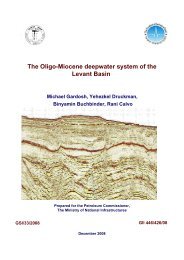The Geology of the Elat Sheet Explanatory Notes
The Geology of the Elat Sheet Explanatory Notes
The Geology of the Elat Sheet Explanatory Notes
You also want an ePaper? Increase the reach of your titles
YUMPU automatically turns print PDFs into web optimized ePapers that Google loves.
5. Landslides and rock collapse<br />
Landslides along <strong>the</strong> slopes <strong>of</strong> <strong>the</strong> rift margins are common as a result <strong>of</strong> <strong>the</strong> tectonic<br />
activity associated with <strong>the</strong> Dead Sea Transform and <strong>the</strong> stratigraphy where rigid<br />
dolomite and limestone beds overlie clay units that serve as <strong>the</strong> lubricant for sliding. <strong>The</strong><br />
common ones are <strong>the</strong> Ger<strong>of</strong>it Formation blocks that slide on top <strong>of</strong> <strong>the</strong> Ora Formation<br />
shales like along <strong>the</strong> Mt. Amram cliffs or <strong>the</strong> basal clays <strong>of</strong> <strong>the</strong> Ger<strong>of</strong>it Formation at <strong>the</strong><br />
upper Nahal Shehoret. Here a series <strong>of</strong> dip fructures striking nor<strong>the</strong>ast were mapped<br />
cutting <strong>the</strong> Gr<strong>of</strong>it Formation parallel to <strong>the</strong> cliffs <strong>of</strong> Nahal Shehoret tributaries. A massive<br />
landslide was observed here at <strong>the</strong> stream bed. Overlaying <strong>the</strong> limestone <strong>of</strong> <strong>the</strong> Gr<strong>of</strong>it<br />
Formation, dipping 10 0 to sou<strong>the</strong>ast, two big blocks <strong>of</strong> sliding Zihor Formation were<br />
mapped. Three landslide scarps in <strong>the</strong> top Hazera Formation <strong>of</strong> ~70X100 meters each<br />
were mapped at <strong>the</strong> south-east flank <strong>of</strong> <strong>the</strong> Raham Syncline. Rock collapse are common<br />
like at <strong>the</strong> upper Nahal Netafim, Nahal Raham and Nahal Shani where huge boulders <strong>of</strong><br />
limestone <strong>of</strong> <strong>the</strong> Zafit Member originally overlaying <strong>the</strong> marly beds <strong>of</strong> <strong>the</strong> En Yorqe'am<br />
Member fill <strong>the</strong> stream. Huge blocks weighting more than 10 tons weighting more than<br />
10 tons <strong>of</strong> <strong>the</strong> Amudei Shelomo and Shehoret formations were mapped along Nahal<br />
Amir.<br />
6. Economic aspects<br />
<strong>The</strong> geological mapping is a major tool for <strong>the</strong> sustainable use <strong>of</strong> natural resources. At <strong>the</strong><br />
<strong>Elat</strong> region where desert tourism is a major income <strong>the</strong> detailed geological map is an<br />
important tour guide. <strong>The</strong> map is also important for planning infrastructure and future<br />
development and to estimate and mitigate <strong>the</strong> high seismic risk <strong>of</strong> this area along <strong>the</strong><br />
Dead Sea Transform. Typical examples are <strong>the</strong> studies <strong>of</strong> Tahal Engineers (Tahal<br />
Engineers, 2002; Israeli and Harash, 1990) and <strong>of</strong> <strong>the</strong> Geological Survey (Zilberman et<br />
al., 2001) <strong>of</strong> <strong>the</strong> Roded and Shahmon sites. <strong>The</strong> intense solar radiation and <strong>the</strong> flat vacant<br />
plains make <strong>the</strong> area also an ideal location for <strong>the</strong> production <strong>of</strong> solar energy. <strong>The</strong><br />
elevated topography <strong>of</strong> <strong>the</strong> rift margins adjacent to <strong>the</strong> <strong>Elat</strong>/Aqaba Gulf is ideal for pump<br />
storage which is essential for solar energy and electrical net end users. At <strong>the</strong> Amram<br />
Pillars mainly in <strong>the</strong> Amir Formation ancient copper mines <strong>of</strong> <strong>the</strong> Egyptian and Muslim<br />
periods were excavated (Willies, 1991) and traces <strong>of</strong> gold were found in <strong>the</strong> rhyolite<br />
dykes <strong>of</strong> Nahal Shehoret and Nahal Roded (Bogosh et al., 1993). Twelve million m 3 <strong>of</strong><br />
brackish water are pumped annually and are desalinized for <strong>the</strong> use <strong>of</strong> <strong>the</strong> local<br />
population. This brackish water is a mix <strong>of</strong> <strong>the</strong> fossil salty water from <strong>the</strong> sandstone<br />
aquifer <strong>of</strong> <strong>the</strong> Yam Suf and Kurnub groups with fresh renewable water from <strong>the</strong> alluvial<br />
fans (Bein et al., 1993). <strong>The</strong> potential <strong>of</strong> raw material for <strong>the</strong> construction industry was<br />
summarized by Shirav and Segev (1995).<br />
7. Previous studies<br />
Numerous geological studies were carried out in <strong>the</strong> <strong>Elat</strong> area and not all <strong>of</strong> <strong>the</strong>m are<br />
included here. We refer mainly to those that directly contribute to <strong>the</strong> map and <strong>the</strong><br />
explanatory notes. <strong>The</strong> <strong>Elat</strong> area was previously mapped by Bentor and Vroman (1955) at<br />
1:100,000 scale; Garfunkel (1970) at 1:50,000 scale; Druckman et al. (1993) at 1:100,000<br />
scale and Garfunkel et al. (2000) at 1:100,000 scale. Specific areas previously mapped in<br />
more detail and compiled into <strong>the</strong> present map are: Y. Eyal (1967), Bartov (1967),<br />
11

















